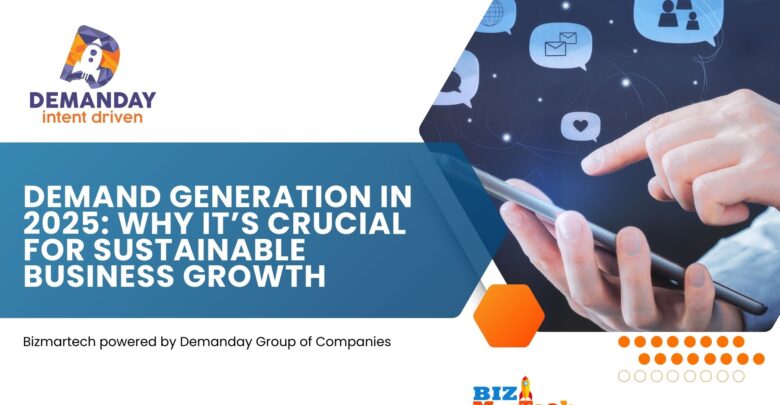Digital Marketing
Demand Generation in 2025: Why It’s Crucial for Sustainable Business Growth

As we approach 2025, digital technology continues to proliferate. Businesses recognize the importance of demand generation as a pivotal strategy for sustainable growth. Demand generation encompasses diverse marketing activities designed to create awareness and interest in a company’s products or services. In this article, backed by recent data and examples, we will explore why demand generation is crucial for business growth in 2025.
Understanding Demand Generation
Demand generation is more than just lead generation; it is developing a comprehensive strategy that integrates marketing and sales efforts to generate interest in a product or service. It involves instructing potential clients, building relationships, and eventually turning prospects into committed customers. In 2025, companies that focus on demand generation will be better equipped to thrive in an increasingly competitive market.
The Shift in Consumer Behavior
A recent study finds that a substantial shift in customer behavior. According to a report from McKinsey, over 70% of consumers prefer to engage with brands that offer personalized experiences. Furthermore, 60% of consumers expect brands to provide relevant content during their buying journey. This shift highlights the need for businesses to adopt a customer-centric approach in their demand generation strategies.
The Importance of Demand Generation in 2025
1. Building Brand Awareness and Trust
As more businesses enter the market, standing out is essential. A successful demand generation strategy helps build brand awareness and establishes trust. For instance, companies like HubSpot have effectively utilized content marketing, providing valuable resources and insights that resonate with their target audience. This approach not only fosters trust but also positions them as industry leaders.
2. Enhancing Lead Quality
In 2025, quality over quantity will remain a decisive factor in lead generation. With advancements in AI and data analytics, businesses can now target specific customer segments more effectively. For example, Salesforce’s Einstein AI provides companies with predictive analytics that help identify high-quality leads based on user behavior. By focusing on demand generation, businesses can refine their lead acquisition processes, resulting in higher conversion rates.
3. Nurturing Relationships through Engagement
Demand generation involves building relationships with prospects. In 2025, engaging content will be vital. According to a study by the Content Marketing Institute, 80% of marketers who use engaging content report higher sales. For instance, Nike uses personalized email marketing campaigns and social media engagement to maintain an ongoing relationship with its customers, fostering loyalty and repeat business.
4. Supporting Customer Education
As consumers become more informed, companies must play an active role in their education. Businesses that provide valuable content, such as webinars, guides, and case studies, can effectively demonstrate their expertise and address the common pain points of their audience. In 2025, integrating educational content into demand generation efforts will help bridge the knowledge gap and empower consumers to make informed decisions.
5. Leveraging Technology and Data
The continued integration of technology into marketing strategies cannot be overlooked. With tools like CRM software and marketing automation platforms, businesses can streamline their demand generation processes. For instance, platforms like Marketo and HubSpot allow businesses to track user behavior, enabling them to create targeted campaigns that respond to individual needs and preferences. This data-driven approach will be critical for optimizing demand generation in 2025.
Examples of Successful Demand Generation Strategies
- Slack: Slack’s demand generation strategy involves webinars and educational content to inform potential users about its platform’s benefits. These initiatives have helped Slack create a loyal user base and drive organic growth.
- Dropbox: Dropbox leverages referral programs as part of its demand generation strategy. By incentivizing current users to refer the platform to their networks, Dropbox successfully increased its user base and enhanced brand visibility.
- Airbnb: Airbnb employs localized content marketing to attract hosts and guests. By creating content that resonates with specific markets, Airbnb effectively generates demand in diverse regions, driving growth and expanding its user network.
Upcoming Trends in Demand Generation
Looking ahead to 2025 and beyond, various trends shape the future of demand creation.
- Increased Personalization: As technology continues to advance, consumers will expect even more personalized experiences. Businesses that can deliver tailored content and experiences will stand out in the market.
- AI and Automation: Artificial intelligence will continue to revolutionize demand generation by providing enhanced data analysis and customer insights. Automating lengthy procedures will allow marketing teams to focus on key projects.
- Sustainability and Social Responsibility: More consumers prefer brands that align with their values, including sustainability. Companies that incorporate these elements into their demand generation strategies will resonate more with their target market.
- Video Content Dominance: Video content will remain critical, with projections showing that it will drive more than 80% of all online traffic by 2025. Brands that leverage live streams, tutorials, and engaging video content in their strategies will capture audience attention effectively.
Conclusion
As we enter 2025, demand generation will play a crucial role in the sustainable growth of businesses across industries. By building relationships, enhancing lead quality, and leveraging technology, companies can create effective demand generation strategies that resonate with their target audience. In a world where consumer behavior continually changes, staying ahead of the curve with innovative demand generation tactics will be essential for long-term success.
Businesses can lay the groundwork for a thriving, sustainable future by prioritizing demand generation today. Are you ready to elevate your demand generation strategy and secure your business growth in 2025?




